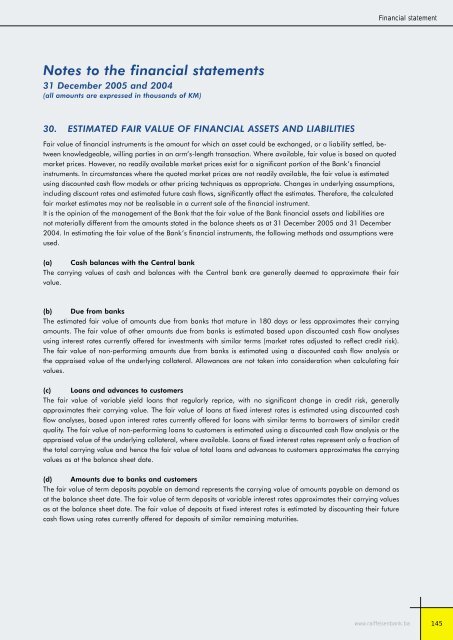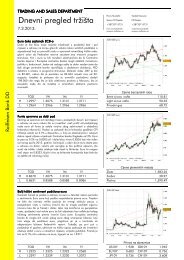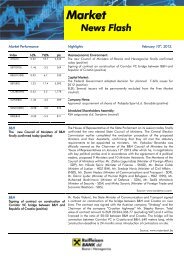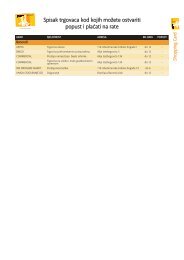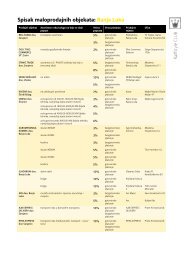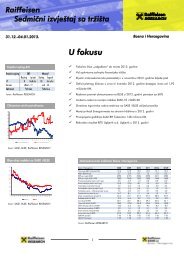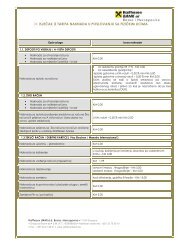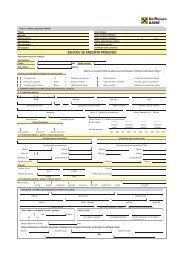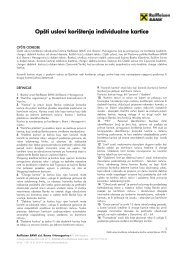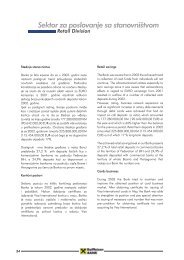Bilansi uspjeha - Raiffeisen Bank
Bilansi uspjeha - Raiffeisen Bank
Bilansi uspjeha - Raiffeisen Bank
You also want an ePaper? Increase the reach of your titles
YUMPU automatically turns print PDFs into web optimized ePapers that Google loves.
Notes to the financial statements<br />
31 December 2005 and 2004<br />
(all amounts are expressed in thousands of KM)<br />
30. ESTIMATED FAIR VALUE OF FINANCIAL ASSETS AND LIABILITIES<br />
Fair value of financial instruments is the amount for which an asset could be exchanged, or a liability settled, between<br />
knowledgeable, willing parties in an arm’s-length transaction. Where available, fair value is based on quoted<br />
market prices. However, no readily available market prices exist for a significant portion of the <strong>Bank</strong>’s financial<br />
instruments. In circumstances where the quoted market prices are not readily available, the fair value is estimated<br />
using discounted cash flow models or other pricing techniques as appropriate. Changes in underlying assumptions,<br />
including discount rates and estimated future cash flows, significantly affect the estimates. Therefore, the calculated<br />
fair market estimates may not be realisable in a current sale of the financial instrument.<br />
It is the opinion of the management of the <strong>Bank</strong> that the fair value of the <strong>Bank</strong> financial assets and liabilities are<br />
not materially different from the amounts stated in the balance sheets as at 31 December 2005 and 31 December<br />
2004. In estimating the fair value of the <strong>Bank</strong>’s financial instruments, the following methods and assumptions were<br />
used.<br />
(a) Cash balances with the Central bank<br />
The carrying values of cash and balances with the Central bank are generally deemed to approximate their fair<br />
value.<br />
(b) Due from banks<br />
The estimated fair value of amounts due from banks that mature in 180 days or less approximates their carrying<br />
amounts. The fair value of other amounts due from banks is estimated based upon discounted cash flow analyses<br />
using interest rates currently offered for investments with similar terms (market rates adjusted to reflect credit risk).<br />
The fair value of non-performing amounts due from banks is estimated using a discounted cash flow analysis or<br />
the appraised value of the underlying collateral. Allowances are not taken into consideration when calculating fair<br />
values.<br />
(c) Loans and advances to customers<br />
The fair value of variable yield loans that regularly reprice, with no significant change in credit risk, generally<br />
approximates their carrying value. The fair value of loans at fixed interest rates is estimated using discounted cash<br />
flow analyses, based upon interest rates currently offered for loans with similar terms to borrowers of similar credit<br />
quality. The fair value of non-performing loans to customers is estimated using a discounted cash flow analysis or the<br />
appraised value of the underlying collateral, where available. Loans at fixed interest rates represent only a fraction of<br />
the total carrying value and hence the fair value of total loans and advances to customers approximates the carrying<br />
values as at the balance sheet date.<br />
(d) Amounts due to banks and customers<br />
The fair value of term deposits payable on demand represents the carrying value of amounts payable on demand as<br />
at the balance sheet date. The fair value of term deposits at variable interest rates approximates their carrying values<br />
as at the balance sheet date. The fair value of deposits at fixed interest rates is estimated by discounting their future<br />
cash flows using rates currently offered for deposits of similar remaining maturities.<br />
Financial statement<br />
www.raiffeisenbank.ba<br />
145


